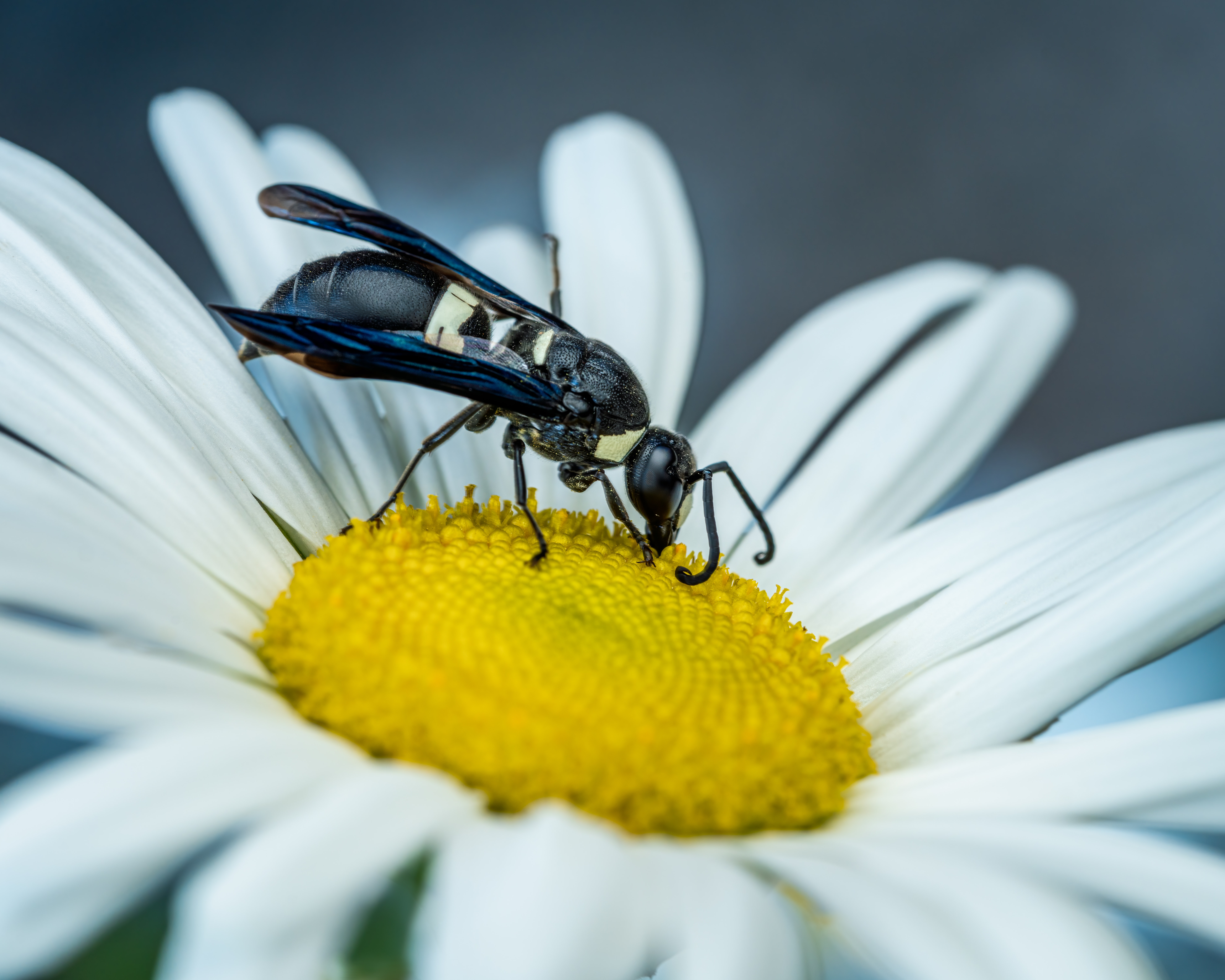
By Thomas Christopher
The Pleasures (Really) of Wasps
When I began my education as a gardener almost 50 years ago, one was considered notably enlightened if the practitioner distinguished “good bugs” from the “the bad bugs.” The bad bugs – or more broadly and accurately, the bad insects – were those that fed on our plants; the good insects were the predatory species that preyed upon the plant-eating ones. Since those days, I’ve learned to appreciate the herbivorous insects, many of which are beautiful and fascinating in their own right, if you only take the time to look when you are out in the garden. They are also, of course, an essential food source for garden wildlife.
One class of insects I would definitely have classified as bad in years gone by are wasps. I’d had some unfortunate experiences with them, principally with yellow jackets, and saw no reason to distinguish one wasp from another. That changed recently, however, when I began reading Heather Holm’s excellent new book, Wasps: Their Biology, Diversity, and Role as Beneficial Insects and Pollinators of Native Plants. This book provides a field guide to some 150 species of the more common and prominent wasps of the eastern United States. Among them I found many fascinating creatures and learned about the essential role that wasps play in making our garden ecosystems work.
In a recent conversation with Heather Holm, I learned that the wasps that leave bad experiences (and she has had those, too) are the so-called “social wasps,” the small minority of species such as paper wasps and yellow jackets that live together in large communal nests. Perhaps because these aggregations are especially attractive to predators, these social wasps tend to be fiercely defensive and to offend one is to rouse a swarm. Most of the wasps in Heather’s book are solitary species. That is, they nest alone and don’t ordinarily associate with each other except to mate.
Heather described to me a number of the wasps that particularly fascinate her. There is the remarkable adaptation of the eastern ant queen kidnapper wasp, for example, which preys on ant queens when they emerge from their nests for their mating flights. The wasp will only prey upon an ant queen during the brief period when it is winged; the wasp stings the queen and takes it back to her nest to serve as food for the growing wasp larvae.
Most of the solitary wasps are predators of this sort, according to Heather, though their prey varies with the species, some wasps focusing on plant bugs or caterpillars, whereas others may specialize in grasshoppers or katydids. This prey is taken for the benefit of the wasps’ larvae. The adults are not carnivores, but rather subsist on flower nectar. To sip this, the wasps move from blossoms to blossom, inadvertently bringing pollen with them and so fertilizing the flowers they visit.
Another group that particularly intrigues Heather is the potter and mason wasps. Many wasps create subterranean nests, but the potter and mason wasps nest above ground, and construct their lairs out of mud. Some use this material to create partitions, creating individual rooms for wasp larvae within existing cavities in dead trees, hollow stems, or even bee hotels. Other wasps within this group create free-form mud nests. The potter wasps, for example, make jug-shaped nests which they fill with caterpillars for their larvae to feed on before capping the mouths with more mud. The series of parallel mud tubes I found last summer plastered to the wall of my breezeway Heather identified as the work of the organ pipe mud dauber wasp.
Thanks to this book, I have found new respect for these residents of my garden. I’ll be looking for wasps visiting my flowers this summer, and am hoping for the return of that talented organ pipe builder. And those I don’t recognize, I’ll look up in this beautifully illustrated and informative field guide.
For more information about Wasps, listen in on my conversation with Heather Hold on the Berkshire Botanical Garden Growing Greener podcast at thomaschristophergardens.com/podcast.
Be-a-Better-Gardener is a community service of Berkshire Botanical Garden, located in Stockbridge, MA. Its mission, to provide knowledge of gardening and the environment through a diverse range of classes and programs, informs and inspires thousands of students and visitors each year. Thomas Christopher is a volunteer at Berkshire Botanical Garden and is the author or co-author of more than a dozen books, including Nature into Art and The Gardens of Wave Hill (Timber Press, 2019). He is the 2021 Garden Club of America’s National Medalist for Literature, a distinction reserved to recognize those who have left a profound and lasting impact on issues that are most important to the GCA. Tom’s companion broadcast to this column, Growing Greener, streams on WESUFM.org, Pacifica Radio and NPR and is available at his website, https://www.thomaschristophergardens.com/podcast.
Caption: Heather Holm’s excellent new book, Wasps: Their Biology, Diversity, and Role as Beneficial Insects and Pollinators of Native Plants provides a field guide to some 150 species of the more common and prominent wasps of the eastern United States.

 Thomas Christopher is the co-author of “Garden Revolution” (Timber Press, 2016) and is a volunteer at Berkshire Botanical Garden. berkshirebotanical.org Be-a-Better-Gardener is a community service of Berkshire Botanical Garden, one of the nation’s oldest botanical gardens in Stockbridge, MA. Its mission to provide knowledge of gardening and the environment through 25 display gardens and a diverse range of classes informs and inspires thousands of students and visitors on horticultural topics every year. Thomas Christopher is the co-author of Garden Revolution (Timber press, 2016) and is a volunteer at Berkshire Botanical Garden. berkshirebotanical.org.
Thomas Christopher is the co-author of “Garden Revolution” (Timber Press, 2016) and is a volunteer at Berkshire Botanical Garden. berkshirebotanical.org Be-a-Better-Gardener is a community service of Berkshire Botanical Garden, one of the nation’s oldest botanical gardens in Stockbridge, MA. Its mission to provide knowledge of gardening and the environment through 25 display gardens and a diverse range of classes informs and inspires thousands of students and visitors on horticultural topics every year. Thomas Christopher is the co-author of Garden Revolution (Timber press, 2016) and is a volunteer at Berkshire Botanical Garden. berkshirebotanical.org.
